-
 Predictive Factors of Cytomegalovirus Colonic Reactivation in Patients with Active Ulcerative Colitis
Predictive Factors of Cytomegalovirus Colonic Reactivation in Patients with Active Ulcerative Colitis -
 Elements in the 5′ Untranslated Region of Viral RNA Important for HIV Gag Recognition and Cross-Packaging
Elements in the 5′ Untranslated Region of Viral RNA Important for HIV Gag Recognition and Cross-Packaging -
 First Report of Paralytic Rabies in a Lowland Tapir (Tapirus terrestris) in Argentina
First Report of Paralytic Rabies in a Lowland Tapir (Tapirus terrestris) in Argentina -
 The In Situ Structure of T-Series T1 Reveals a Conserved Lambda-Like Tail Tip
The In Situ Structure of T-Series T1 Reveals a Conserved Lambda-Like Tail Tip -
 Exploring the Contribution of TLR7 to Sex-Based Disparities in Respiratory Syncytial Virus (RSV)-Induced Inflammation and Immunity
Exploring the Contribution of TLR7 to Sex-Based Disparities in Respiratory Syncytial Virus (RSV)-Induced Inflammation and Immunity
Journal Description
Viruses
Viruses
is a peer-reviewed, open access journal of virology, published monthly online by MDPI. The Spanish Society for Virology (SEV), Canadian Society for Virology (CSV), Italian Society for Virology (SIV-ISV), Australasian Virology Society (AVS), Brazilian Society for Virology (BSV) and others are affiliated with Viruses and their members receive a discount on the article processing charges.
- Open Access— free for readers, with article processing charges (APC) paid by authors or their institutions.
- High Visibility: indexed within Scopus, SCIE (Web of Science), PubMed, MEDLINE, PMC, Embase, PubAg, AGRIS, and other databases.
- Journal Rank: JCR - Q2 (Virology) / CiteScore - Q1 (Infectious Diseases)
- Rapid Publication: manuscripts are peer-reviewed and a first decision is provided to authors approximately 18.6 days after submission; acceptance to publication is undertaken in 2.5 days (median values for papers published in this journal in the first half of 2025).
- Recognition of Reviewers: reviewers who provide timely, thorough peer-review reports receive vouchers entitling them to a discount on the APC of their next publication in any MDPI journal, in appreciation of the work done.
- Companion journal: Zoonotic Diseases.
Impact Factor:
3.5 (2024);
5-Year Impact Factor:
3.7 (2024)
Latest Articles
mRNA Vaccine Development in the Fight Against Zoonotic Viral Diseases
Viruses 2025, 17(7), 960; https://doi.org/10.3390/v17070960 - 8 Jul 2025
Abstract
Zoonotic diseases are transmitted from animals to humans, and they impose a significant global burden by impacting both animal and human health. It can lead to substantial economic losses and cause millions of human deaths. The emergence and re-emergence of zoonotic diseases are
[...] Read more.
Zoonotic diseases are transmitted from animals to humans, and they impose a significant global burden by impacting both animal and human health. It can lead to substantial economic losses and cause millions of human deaths. The emergence and re-emergence of zoonotic diseases are heavily influenced by both anthropogenic and natural drivers such as climate change, rapid urbanization, and widespread travel. Over time, the unprecedented rise of new and re-emerging zoonotic diseases has prompted the need for rapid and effective vaccine development. Following the success of the COVID-19 mRNA vaccines, mRNA-based platforms hold great promise due to their rapid design, swift development and ability to elicit robust immune responses, thereby highlighting their potential in combating emerging and pre-pandemic zoonotic viruses. In recent years, several mRNA vaccines targeting emerging and re-emerging zoonotic viral diseases, such as rabies, Nipah, Zika, and influenza, have advanced to clinical trials, demonstrating promising immunogenicity. This review explores recent advances, challenges, and future directions in developing mRNA vaccines against emerging and re-emerging zoonotic viral diseases.
Full article
(This article belongs to the Special Issue Emerging and Re-Emerging Zoonotic Viruses: Current Challenges in Vaccinology)
►
Show Figures
Open AccessCommentary
The Meandrous Route of Rilpivirine in the Search for the Miraculous Drug to Treat HIV Infections
by
Erik De Clercq
Viruses 2025, 17(7), 959; https://doi.org/10.3390/v17070959 - 8 Jul 2025
Abstract
Rilpivirine (RPV, R278474) was highlighted in 2005, two years after the death of Dr. Paul Janssen, as the ideal non-nucleoside reverse transcriptase inhibitor (NNRTI) to treat HIV infections. For this purpose, it was subsequently combined with tenofovir disoproxil fumarate (TDF), tenofovir alafenamide (TAF),
[...] Read more.
Rilpivirine (RPV, R278474) was highlighted in 2005, two years after the death of Dr. Paul Janssen, as the ideal non-nucleoside reverse transcriptase inhibitor (NNRTI) to treat HIV infections. For this purpose, it was subsequently combined with tenofovir disoproxil fumarate (TDF), tenofovir alafenamide (TAF), darunavir (boosted with ritonavir or cobicistat) or dolutegravir. Its wide-spread use is thanks to its combination with cabotegravir (CAB) in the form of a long-acting intramuscular injection once per month (QM), later twice per month (Q2M), for the treatment of adults, later extended to adolescents and pregnant women, with HIV infections. The long-acting CAB plus RPV should not be administered in patients treated with rifampicin or rifabutin, patients with virological failure or patients with resistance to CAB or RPV, or patients with hepatitis B virus (HBV) infection. Long-acting CAB+RPV may lead to pain at the site of injection which would diminish over time.
Full article
(This article belongs to the Section Viral Immunology, Vaccines, and Antivirals)
►▼
Show Figures
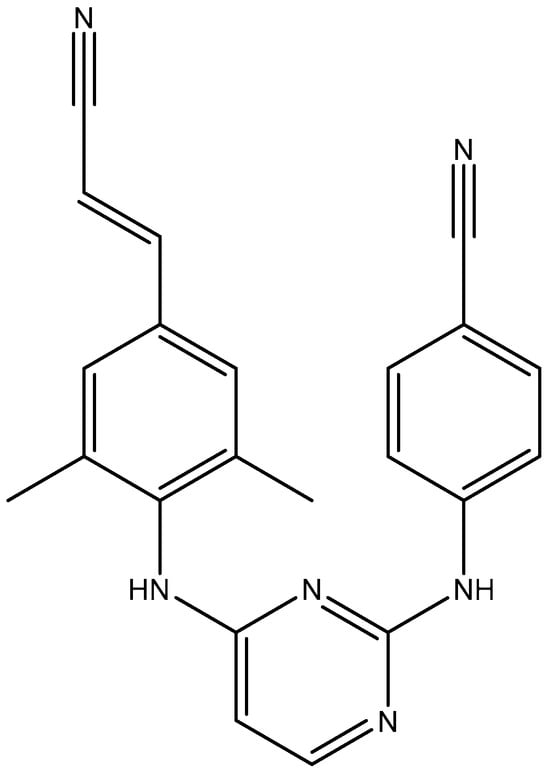
Figure 1
Open AccessArticle
De Novo Expressed Vpr Stimulates HIV-1 Replication in T Cells
by
Blessing Enya and Jacek Skowronski
Viruses 2025, 17(7), 958; https://doi.org/10.3390/v17070958 - 7 Jul 2025
Abstract
Vpr, a virion-associated accessory virulence factor of HIV-1, promotes virus replication in both T cells and macrophages. Although Vpr’s early activity—antagonism of preintegration silencing and host restriction factors—has been documented, the relative contribution of virion-associated versus de novo expressed Vpr to HIV-1 replication
[...] Read more.
Vpr, a virion-associated accessory virulence factor of HIV-1, promotes virus replication in both T cells and macrophages. Although Vpr’s early activity—antagonism of preintegration silencing and host restriction factors—has been documented, the relative contribution of virion-associated versus de novo expressed Vpr to HIV-1 replication fitness remains unclear. Here, we developed a T cell-based system that genetically separates early and late Vpr functions by combining tetracycline-inducible Vpr expression in CEM.SS T cells with vpr-deficient HIV-1 constructs and Gag p6 mutations that block Vpr packaging. CEM.SS T cells have been shown to recapitulate the positive effect of Vpr on HIV-1 replication observed in activated primary T cells. Using pairwise replication fitness assays under spreading infection conditions, we demonstrate that de novo synthesized Vpr exerts the dominant effect on HIV-1 replication in T cells, while virion-associated Vpr plays a lesser role. Somewhat unexpectedly, our findings reveal that antagonism of preintegration HIV-1 silencing by virion-associated Vpr is unlikely to be the major driver of enhanced HIV-1 replication in proliferating T cells. Instead, this function may play a more prominent role in the infection of non-dividing T cells and/or other cell types.
Full article
(This article belongs to the Section Human Virology and Viral Diseases)
►▼
Show Figures
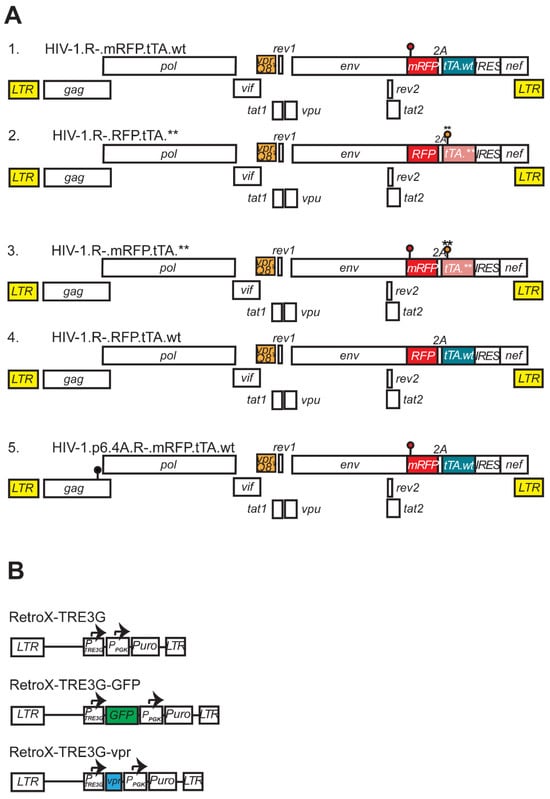
Figure 1
Open AccessArticle
The Role of Comorbidities in COVID-19 Severity
by
Sandra König, Ugne Vaskyte, Maria Boesing, Giorgia Lüthi-Corridori and Joerg Daniel Leuppi
Viruses 2025, 17(7), 957; https://doi.org/10.3390/v17070957 - 7 Jul 2025
Abstract
Background: COVID-19 has led to significant global morbidity and mortality, with clinical outcomes varying widely among individuals. Understanding the impact of comorbidities on COVID-19 outcomes is essential for improving patient management. To date, analyses of comorbidities affecting COVID-19 severity in a heterogeneous Swiss
[...] Read more.
Background: COVID-19 has led to significant global morbidity and mortality, with clinical outcomes varying widely among individuals. Understanding the impact of comorbidities on COVID-19 outcomes is essential for improving patient management. To date, analyses of comorbidities affecting COVID-19 severity in a heterogeneous Swiss cohort across multiple outbreak waves are unavailable. The objective of this study was to explore the role of comorbidities on COVID-19 severity in hospitalized patients from a diverse Swiss cohort and to evaluate the association between comorbidities and specific in-hospital complications. Methods: This retrospective, observational, single-center study included adult patients who were hospitalized for COVID-19 for at least one night at the Cantonal Hospital Baselland, Switzerland (KSBL), between March 2020 and December 2021. Logistic regression analyses adjusted for age and gender were performed to analyze the association between comorbidities and critical condition (defined as severe disease or in-hospital death) and complications. Results: A total of 1124 patients were included in the study (median age 66, range 19–100 years, 60% male). A total of 76% of patients had at least one comorbidity. The most common comorbidities were arterial hypertension (47%), obesity (27%), and diabetes mellitus (24%). Overall, 16% of patients experienced a critical condition, and 25.5% had any type of complication. Patients without comorbidities had the lowest rates of critical condition (5.3%) and complications (10.2%). Obesity (OR 2.01, p < 0.001), diabetes mellitus (OR 1.67, p = 0.004), arterial hypertension (OR 1.65, p = 0.006), arrhythmia (OR1.87, p = 0.003), and chronic obstructive pulmonary disease (OR 2.72, p < 0.001) were found to be associated with critical condition. The most frequently observed complication was acute kidney failure, affecting 17.1% of the study population, while patients with arrhythmia showed the highest overall complication rate (42%). Conclusions: Our findings are consistent with previous research, confirming the relevance of specific comorbidities as key risk factors for critical COVID-19 outcomes. Among all comorbid conditions evaluated, asthma appeared to have the least impact on disease severity. Future research should focus on the impact of the combination of comorbidities on the disease severity of COVID-19, as well as the long-term effects of COVID-19 for patients with certain comorbidities.
Full article
(This article belongs to the Special Issue Emerging Concepts in SARS-CoV-2 Biology and Pathology, 3rd Edition)
►▼
Show Figures
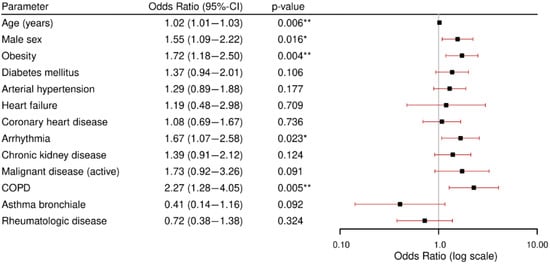
Open AccessArticle
Seroprevalence and Molecular Analysis of Bovine Leukemia Virus in Kazakhstan
by
Saltanat Mamanova, Ainur Nurpeisova, Elvira Bashenova, Saira Kaimoldina, Vladimir Kirpichenko, Perizat Akshalova, Aiken Karabassova, Malik Yussupov, Akzhigit Mashzhan, Dauriya Tazhbayeva, Zhandos Abay, Marzena Rola-Luszczak, Jacek Kuzmak, Raikhan Nissanova and Markhabat Kassenov
Viruses 2025, 17(7), 956; https://doi.org/10.3390/v17070956 - 7 Jul 2025
Abstract
Bovine leukemia virus (BLV) remains a major concern for cattle industries worldwide due to its persistent nature, economic impact, and challenges in control. In this study, we conducted a comprehensive nationwide survey of BLV in Kazakhstan between 2014 and 2024, utilizing serological diagnostics
[...] Read more.
Bovine leukemia virus (BLV) remains a major concern for cattle industries worldwide due to its persistent nature, economic impact, and challenges in control. In this study, we conducted a comprehensive nationwide survey of BLV in Kazakhstan between 2014 and 2024, utilizing serological diagnostics to assess prevalence and characterize viral genotypes (2024). A total of 433,537 serum samples were screened by agar gel immunodiffusion (AGID), revealing an overall seroprevalence of 5.87%, with the highest rates observed in the North Kazakhstan, Kostanay, and East Kazakhstan regions. In 2024, a targeted analysis of 3736 serum and 536 whole blood samples across 17 regions was performed using AGID, ELISA, real-time PCR, and nested PCR. ELISA demonstrated higher sensitivity than AGID (10.4% vs. 8.2%), confirmed by statistical correlation (r = 0.97, p < 0.001) and a Wilcoxon signed-rank test (p = 0.026). Real-time PCR detected BLV DNA in 4.7% of samples, with the highest positivity in the East Kazakhstan and Abai regions, confirming active viral circulation. Validation of a domestically developed AGID diagnostic kit showed full concordance with commercial assays (IDEXX, IDvet), supporting its use in national surveillance programs. These findings highlight the endemic status of BLV in Kazakhstan. Molecular analysis of sequenced isolates revealed the presence of genotype G-7, consistent with strains circulating in neighboring countries. Together, these results underscore the importance of integrated serological and molecular approaches for effective monitoring and control.
Full article
(This article belongs to the Special Issue Viral Diseases of Domestic Animals)
►▼
Show Figures
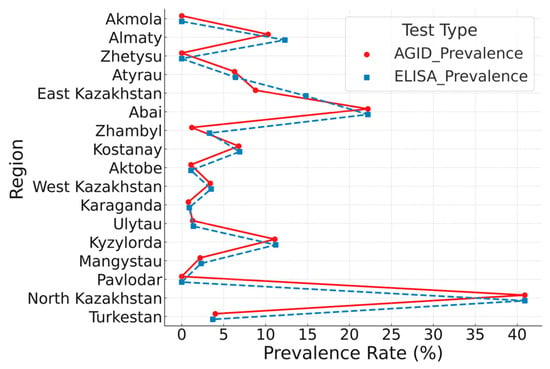
Figure 1
Open AccessArticle
Detection of a Novel Gull-like Clade of Newcastle Disease Virus and H3N8 Avian Influenza Virus in the Arctic Region of Russia (Taimyr Peninsula)
by
Anastasiya Derko, Nikita Dubovitskiy, Alexander Prokudin, Junki Mine, Ryota Tsunekuni, Yuko Uchida, Takehiko Saito, Nikita Kasianov, Arina Loginova, Ivan Sobolev, Sachin Kumar, Alexander Shestopalov and Kirill Sharshov
Viruses 2025, 17(7), 955; https://doi.org/10.3390/v17070955 - 7 Jul 2025
Abstract
Wild waterbirds are circulating important RNA viruses, such as avian coronaviruses, avian astroviruses, avian influenza viruses, and avian paramyxoviruses. Waterbird migration routes cover vast territories both within and between continents. The breeding grounds of many species are in the Arctic, but research into
[...] Read more.
Wild waterbirds are circulating important RNA viruses, such as avian coronaviruses, avian astroviruses, avian influenza viruses, and avian paramyxoviruses. Waterbird migration routes cover vast territories both within and between continents. The breeding grounds of many species are in the Arctic, but research into this region is rare. This study reports the first Newcastle disease virus (NDV) detection in Arctic Russia. As a result of a five-year study (from 2019 to 2023) of avian paramyxoviruses and avian influenza viruses in wild waterbirds of the Taimyr Peninsula, whole-genome sequences of NDV and H3N8 were obtained. The resulting influenza virus isolate was phylogenetically related to viruses that circulated between 2021 and 2023 in Eurasia, Siberia, and Asia. All NDV sequences were obtained from the Herring gull, and other gull sequences formed a separate gull-like clade in the sub-genotype I.1.2.1, Class II. This may indirectly indicate that different NDV variants adapt to more host species than is commonly believed. Further surveillance of other gull species may help to test the hypothesis of putative gull-specific NDV lineage and better understand their role in the evolution and global spread of NDV.
Full article
(This article belongs to the Special Issue Evolution and Adaptation of Avian Viruses)
►▼
Show Figures

Figure 1
Open AccessArticle
The Role of Serum Prolidase Activity, MMP-1, MMP-7, and TGF-β Values in the Prediction of Early Fibrosis in Patients with Moderate to Severe COVID-19
by
Didem Dogu Zengin, Dilek Ergun, Burcu Yormaz, Recai Ergun, Halil Guven, Muslu Kazim Korez, Halil Ozer, Ali Unlu, Baykal Tulek and Fikret Kanat
Viruses 2025, 17(7), 954; https://doi.org/10.3390/v17070954 - 6 Jul 2025
Abstract
Background: This study aims to identify predictive factors for pulmonary fibrosis development in COVID-19 patients by analyzing thorax CT (computed tomography) findings, serum prolidase activity, MMP-1, MMP-7, TGF-β values, laboratory findings, and demographic characteristics. Materials and methods: The investigation involved 68 patients, both
[...] Read more.
Background: This study aims to identify predictive factors for pulmonary fibrosis development in COVID-19 patients by analyzing thorax CT (computed tomography) findings, serum prolidase activity, MMP-1, MMP-7, TGF-β values, laboratory findings, and demographic characteristics. Materials and methods: The investigation involved 68 patients, both male and female, aged 18 years and older, who were volunteers and had been diagnosed with confirmed COVID-19. The pulmonologist and the radiologist evaluated the thorax CT by consensus. Patients were evaluated in two categories, group 1 and group 2, based on the status of fibrotic changes, and 3-month fibrosis scores were calculated. Findings in both lungs were calculated and noted for the lobes, considering lobar spread. Correlations between quantitative parameters were assessed with Spearman’s rho correlation coefficient. Comparisons between independent samples were evaluated using either the independent sample t-test or the Mann–Whitney U test. We evaluated the relationship between categorical variables using the Pearson chi-square test and Fisher’s exact test. Results: Serum prolidase activity, MMP-1, MMP-7, and TGF-β biomarkers were not statistically significant among groups. LDH was found to be significantly high in the group with fibrotic changes. Additionally, the group with fibrotic changes also had higher levels of fibrinogen. The percentage of neutrophils, the severity of the disease, muscle–joint pain and fatigue symptoms, and the length of hospitalization stay were correlated with the total scores of fibrosis at the third month. In the group with fibrotic changes, the duration of muscle–joint pain and fatigue symptoms and the length of hospitalization were longer than in the other group. Conclusions: The group with fibrotic changes showed an increase in biomarkers. However, this increase did not reach a statistically significant level, suggesting that the third month may be an early period for these changes. The group with fibrotic changes showed high levels of LDH, one of the most important laboratory parameters of pulmonary fibrosis risk factors, along with fibrinogen, suggesting that these parameters are valuable in predicting pulmonary fibrosis. Patients with fibrotic changes can experience specific symptoms, commonly seen in COVID-19.
Full article
(This article belongs to the Special Issue SARS-CoV-2, COVID-19 Pathologies, Long COVID, and Anti-COVID Vaccines)
►▼
Show Figures
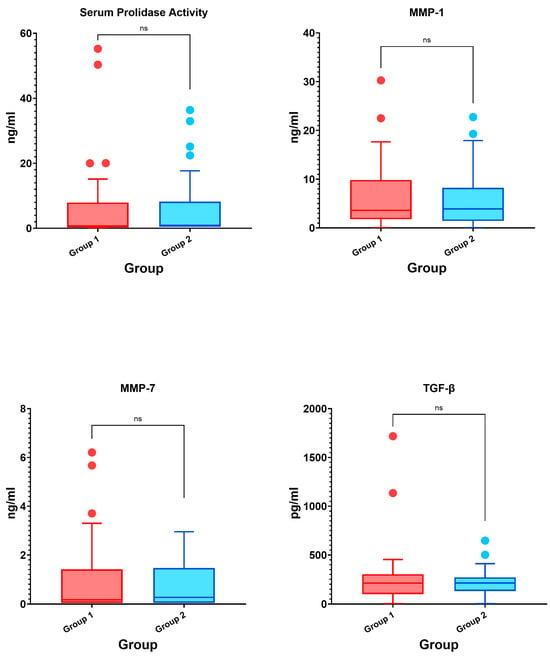
Figure 1
Open AccessArticle
Multiscale Modeling of Hospital Length of Stay for Successive SARS-CoV-2 Variants: A Multi-State Forecasting Framework
by
Minchan Choi, Jungeun Kim, Heesung Kim, Ruarai J. Tobin and Sunmi Lee
Viruses 2025, 17(7), 953; https://doi.org/10.3390/v17070953 - 6 Jul 2025
Abstract
Understanding how hospital length of stay (LoS) evolves with successive SARS-CoV-2 variants is central to the multiscale modeling and forecasting of COVID-19 and other respiratory virus dynamics. Using records from 1249 COVID-19 patients admitted to Chungbuk National University Hospital (2021–2023), we quantified LoS
[...] Read more.
Understanding how hospital length of stay (LoS) evolves with successive SARS-CoV-2 variants is central to the multiscale modeling and forecasting of COVID-19 and other respiratory virus dynamics. Using records from 1249 COVID-19 patients admitted to Chungbuk National University Hospital (2021–2023), we quantified LoS across three distinct variant phases (Pre-Delta, Delta, and Omicron) and three age groups (0–39, 40–64, and 65+ years). A gamma-distributed multi-state model—capturing transitions between semi-critical and critical wards—incorporated variant phase and age as log-linear covariates. Parameters were estimated via maximum likelihood with 95% confidence intervals derived from bootstrap resampling, and Monte Carlo iterations yielded detailed LoS distributions. Omicron-phase stays were 5–8 days, shorter than the 10–14 days observed in earlier phases, reflecting improved treatment protocols and reduced virulence. Younger adults typically stayed 3–5 days, whereas older cohorts required 8–12 days, with prolonged admissions (over 30 days) clustering in the oldest group. These time-dependent transition probabilities can be integrated with real-time bed-availability alert systems, highlighting the need for variant-specific ward/ICU resource planning and underscoring the importance of targeted management for elderly patients during current and future pandemics.
Full article
(This article belongs to the Special Issue Multiscale Modeling and Forecasting of COVID-19 and Respiratory Virus Dynamics)
►▼
Show Figures
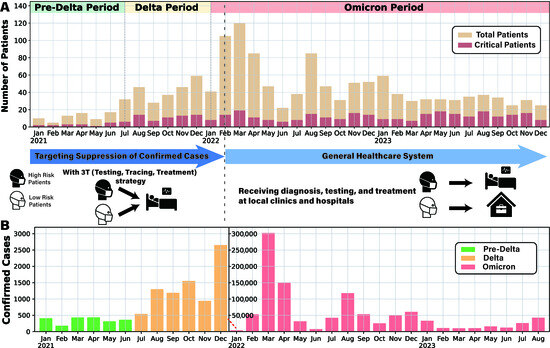
Figure 1
Open AccessCommunication
Complete Sequence Analysis of Grapevine Leafroll-Associated Virus 4 and Interactions Between the Encoded Proteins
by
Tingting Du, Yuxin Hao, Jie Gao, Shane Qiao, Guojun Hu, Fang Ren, Xudong Fan and Yafeng Dong
Viruses 2025, 17(7), 952; https://doi.org/10.3390/v17070952 - 5 Jul 2025
Abstract
Grapevine leafroll disease is one of the most devastating diseases in the global viticulture industry. Grapevine leafroll-associated virus 4 is one of the main pathogens causing this disease. In this study, we obtained the complete genome sequences of two Chinese isolates of GLRaV-4
[...] Read more.
Grapevine leafroll disease is one of the most devastating diseases in the global viticulture industry. Grapevine leafroll-associated virus 4 is one of the main pathogens causing this disease. In this study, we obtained the complete genome sequences of two Chinese isolates of GLRaV-4 from ‘Baisainie’ and ‘Fantasy Seedless’ grapevines through high-throughput sequencing and overlapping RT-PCR combined with RACE technology. The sequences contain 13,814 and 13,824 nucleotides and code six open reading frames, respectively. Phylogenetic trees based on the coat protein (CP) and heat shock protein 70 (HSP70) genes show that in addition to other GLRaV-4 strains (strains 5, 6, 9, Pr, and Car), the GLRaV-4 strains were divided into two distinct groups. The two isolates obtained in this study were classified into separate branches within GLRaV-4 Group 1. Additionally, we systematically investigated the interactions between the proteins encoded by GLRaV-4 using the yeast two-hybrid and bimolecular fluorescence complementation techniques. We found significant interactions between the GLRaV-4-encoded p23 and HSP70 and CP. This study first reports the complete genomes of two different GLRaV-4 isolates from China and suggests that p23 protein encoded by GLRaV-4 may play an important role in viral pathogenicity due to its interactions with the other two proteins.
Full article
(This article belongs to the Special Issue Diversity and Coinfections of Plant or Fungal Viruses, 3rd Edition)
►▼
Show Figures

Figure 1
Open AccessArticle
Syzygium aromaticum Phytoconstituents Target SARS-CoV-2: Integrating Molecular Docking, Dynamics, Pharmacokinetics, and miR-21 rs1292037 Genotyping
by
Mustafa Ahmed Muhmood, Faiza Safi, Mohammed Mukhles Ahmed and Safaa Abed Latef Almeani
Viruses 2025, 17(7), 951; https://doi.org/10.3390/v17070951 - 5 Jul 2025
Abstract
Background and aim: The COVID-19 pandemic, caused by SARS-CoV-2, remains a global health crisis despite vaccination efforts, necessitating novel therapeutic strategies. Natural compounds from Syzygium aromaticum (clove), such as eugenol and β-caryophyllene, exhibit antiviral and anti-inflammatory properties, while host genetic factors, including miR-21
[...] Read more.
Background and aim: The COVID-19 pandemic, caused by SARS-CoV-2, remains a global health crisis despite vaccination efforts, necessitating novel therapeutic strategies. Natural compounds from Syzygium aromaticum (clove), such as eugenol and β-caryophyllene, exhibit antiviral and anti-inflammatory properties, while host genetic factors, including miR-21 rs1292037 polymorphism, may influence disease susceptibility and severity. This study investigates the dual approach of targeting SARS-CoV-2 via Syzygium aromaticum phytoconstituents while assessing the role of miR-21 rs1292037 in COVID-19 pathogenesis. Methods: Firstly, molecular docking and molecular dynamics simulations were employed to assess the binding affinities of eugenol and caryophyllene against seven key SARS-CoV-2 proteins—including Spike-RBD, 3CLpro, and RdRp—using SwissDock (AutoDock Vina) and the Desmond software package, respectively. Secondly, GC-MS was used to characterize the composition of clove extract. Thirdly, pharmacokinetic profiles were predicted using in silico models. Finally, miR-21 rs1292037 genotyping was performed in 100 COVID-19 patients and 100 controls, with cytokine and coagulation markers analyzed. Results: Docking revealed strong binding of eugenol to viral Envelope Protein (−5.267 kcal/mol) and caryophyllene to RdRp (−6.200 kcal/mol). ADMET profiling indicated favorable absorption and low toxicity. Molecular dynamics simulations confirmed stable binding of methyl eugenol and caryophyllene to SARS-CoV-2 proteins, with caryophyllene–7Z4S showing the highest structural stability, highlighting its strong antiviral potential. Genotyping identified the TC genotype as prevalent in patients (52%), correlating with elevated IL-6 and D-dimer levels (p ≤ 0.01), suggesting a hyperinflammatory phenotype. Males exhibited higher ferritin and D-dimer (p < 0.0001), underscoring sex-based disparities. Conclusion: The bioactive constituents of Syzygium aromaticum exhibit strong potential as multi-target antivirals, with molecular simulations highlighting caryophyllene’s particularly stable interaction with the 7Z4S protein. Methyl eugenol also maintained consistent binding across several SARS-CoV-2 targets. Additionally, the miR-21 rs1292037 polymorphism may influence COVID-19 severity through its role in inflammatory regulation. Together, these results support the combined application of phytochemicals and genetic insights in antiviral research, pending further clinical verification.
Full article
(This article belongs to the Special Issue Recent Advances in Antiviral Natural Products 2025)
►▼
Show Figures

Graphical abstract
Open AccessArticle
Unexpected Predictors of Mortality During a DENV-3 Outbreak in Western Mexico: Seizures, Polyserositis, and Renal Dysfunction Without Severe Thrombocytopenia
by
Martha A. Mendoza-Hernandez, Janet Diaz-Martinez, Gustavo A. Hernández-Fuentes, Fabian Rojas-Larios, Katya A. Cárdenas-Cárdenas, Paulina García de León-Flores, David A. Rojas-Cruz, Roberto Aceves-Calvario, Ernesto Gómez-Sandoval, Montserrat Árciga-García, José Guzmán-Esquivel, Valery Melnikov, Francisco Espinoza-Gómez and Iván Delgado-Enciso
Viruses 2025, 17(7), 950; https://doi.org/10.3390/v17070950 - 4 Jul 2025
Abstract
Dengue mortality has traditionally been associated with severe thrombocytopenia and hemorrhagic complications. However, during 2024, dengue virus serotype 3 (DENV-3) increased significantly in western Mexico, leading to the emergence of a distinct clinical pattern. We conducted a retrospective cohort study of hospitalized dengue
[...] Read more.
Dengue mortality has traditionally been associated with severe thrombocytopenia and hemorrhagic complications. However, during 2024, dengue virus serotype 3 (DENV-3) increased significantly in western Mexico, leading to the emergence of a distinct clinical pattern. We conducted a retrospective cohort study of hospitalized dengue patients at the General Hospital of Colima (January–August 2024). Clinical features, laboratory parameters, and outcomes were compared between survivors and non-survivors. Among 201 hospitalized patients, 6 (3.0%) died. All deceased patients presented with generalized seizures, polyserositis (pleural effusion and/or ascites), and required mechanical ventilation. Contrary to classical patterns, they did not have severe thrombocytopenia. Instead, they showed significantly higher white blood cell counts and notably increased levels of serum urea and BUN, suggesting early renal impairment. ROC analysis indicated that BUN (AUC 0.904) and urea (AUC 0.906) were good to excellent discriminators of mortality. During 2024, with an increase in DENV-3 circulation, mortality was associated with neurological and systemic complications, including seizures and polyserositis, as well as biochemical evidence of renal dysfunction—but not with severe thrombocytopenia. These findings challenge current paradigms and highlight the need for early recognition of atypical clinical patterns.
Full article
(This article belongs to the Special Issue Preparation for the Next Potential Pandemic—Chikungunya, Dengue, Zika and Other Viruses)
Open AccessArticle
Real-World Treatment Efficacy and Safety Profile of Sofosbuvir- and Velpatasvir-Based HCV Treatment in South Korea: Multicenter Prospective Study
by
Jae Hyun Yoon, Chang Hun Lee, Hoon Gil Jo, Ju-Yeon Cho, Jin Dong Kim, Jin Won Kim, Ga Ram You, Sung Bum Cho and Sung Kyu Choi
Viruses 2025, 17(7), 949; https://doi.org/10.3390/v17070949 - 4 Jul 2025
Abstract
Background: The advent of direct-acting antivirals (DAAs) has marked a significant milestone in the therapeutic landscape of hepatitis C, greatly improving treatment efficacy. A therapeutic regimen encompassing sofosbuvir (SOF), velpatasvir (VEL), and voxilaprevir (VOX) has demonstrated strong efficacy across all genotypes of the
[...] Read more.
Background: The advent of direct-acting antivirals (DAAs) has marked a significant milestone in the therapeutic landscape of hepatitis C, greatly improving treatment efficacy. A therapeutic regimen encompassing sofosbuvir (SOF), velpatasvir (VEL), and voxilaprevir (VOX) has demonstrated strong efficacy across all genotypes of the hepatitis C virus (HCV) and has recently been incorporated into the Korean healthcare system. This study aimed to evaluate the real-world efficacy and safety of these antivirals in the South Korean population. Methods: This prospective, multicenter, observational study enrolled patients with chronic HCV treated with SOF/VEL-based regimens at six hospitals between November 2022 and January 2024. DAA-naïve patients received SOF/VEL ± ribavirin for 12 weeks. Patients who had failed prior DAA therapy received SOF/VEL/VOX for 12 weeks. The primary endpoint was a sustained virological response at 12 weeks post-treatment (SVR12). Results: Among 101 patients treated with SOF/VEL, the mean age was 64.71 years, and 40.9% were male. Genotypes 1b and 2 were identified in 40.6% and 59.4% of patients, respectively. Two patients had a history of interferon-based treatment. The mean baseline HCV RNA level was 3,088,097 IU/mL. Cirrhosis was observed in 26.7% of patients (21.8% compensated; 5.0% decompensated). Of the 101 patients, 12 were lost to follow-up. Among the 89 patients who completed follow-up, SVR12 was achieved in 100.0% (89/89), including 5 patients with decompensated cirrhosis. In the SOF/VEL/VOX group, 17 patients were treated. The mean age was 61.84 years, 29.4% were male, and four had compensated cirrhosis. One patient was lost to follow-up. SVR12 was achieved in 100.0% (16/16) of the patients who completed follow-up. No serious adverse events (≥grade 3) were reported in either group during the DAA treatment period. Conclusions: In this first prospective real-world study in South Korea, SOF/VEL-based regimens demonstrated excellent efficacy and safety, achieving 100% SVR12 in the per-protocol population, including patients with cirrhosis and prior treatment failure.
Full article
(This article belongs to the Special Issue Advancing Hepatitis Elimination: HBV, HDV, and HCV)
►▼
Show Figures

Figure 1
Open AccessArticle
Detection of Feline Coronavirus RNA in Cats with Feline Infectious Peritonitis and Their Housemates
by
Phoenix M. Shepherd, Amy Elbe, Brianna M. Lynch, Erin Lashnits and Robert N. Kirchdoerfer
Viruses 2025, 17(7), 948; https://doi.org/10.3390/v17070948 - 4 Jul 2025
Abstract
Feline coronavirus (FCoV), the causative agent behind feline infectious peritonitis (FIP), is one of the biggest infectious threats to feline health. Despite this threat, the tissue distribution and viral RNA levels in cats infected with feline coronaviruses are poorly understood in the context
[...] Read more.
Feline coronavirus (FCoV), the causative agent behind feline infectious peritonitis (FIP), is one of the biggest infectious threats to feline health. Despite this threat, the tissue distribution and viral RNA levels in cats infected with feline coronaviruses are poorly understood in the context of natural infection. Here, we used a two-step reverse-transcription quantitative PCR (RT-qPCR) to examine viral RNA levels from different sampling sites in both cats that have been clinically suspected of FIP and their feline housemates. We show that the distribution and amount of FCoV viral RNA does not differ between FCoV-infected cats with FIP and their feline housemates in blood, conjunctiva, or feces. Furthermore, in all FIP and non-FIP cases, viral RNA levels were higher in fecal samples than the blood. Taken together, these results show that amount of viral RNA does not differ between FCoV-infected cats with FIP and their healthy housemates in several sample types. Our results indicate a need for closer examination of FCoV pathogenesis independent of viral dissemination, including an assessment of intrahost evolution of FCoVs and FCoVs’ interactions with the feline immune system.
Full article
(This article belongs to the Section Animal Viruses)
►▼
Show Figures
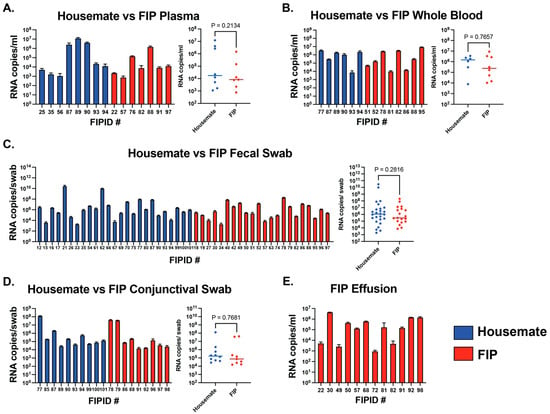
Figure 1
Open AccessArticle
Equine Parvovirus-Hepatitis Population Dynamics in a Single Horse over 16 Years
by
Alexandra J. Scupham
Viruses 2025, 17(7), 947; https://doi.org/10.3390/v17070947 - 4 Jul 2025
Abstract
Many viruses mutate rapidly to adapt to host defenses, and for some of these viruses, the result is long-term infection in individual hosts. The work described here examines the infection and long-term maintenance of a newly identified virus, equine parvovirus-hepatitis (EqPV-H), in an
[...] Read more.
Many viruses mutate rapidly to adapt to host defenses, and for some of these viruses, the result is long-term infection in individual hosts. The work described here examines the infection and long-term maintenance of a newly identified virus, equine parvovirus-hepatitis (EqPV-H), in an individual horse. This description is possible because of a hypervariable region in the capsid gene; sequence variants were tracked by high-throughput sequencing of serum samples taken over a 16-year period. The data support the hypothesis that EqPV-H infection resulted in a sequence variant bottleneck. The continuing infection evolved into a complex viral population showing a pattern of emergence, dominance, and recession with replacement. This is the first temporal description of the capsid gene evolution of EqPV-H in a single animal.
Full article
(This article belongs to the Special Issue Bioinformatics and Computational Approaches in Viral Genomics and Evolution 2025)
►▼
Show Figures
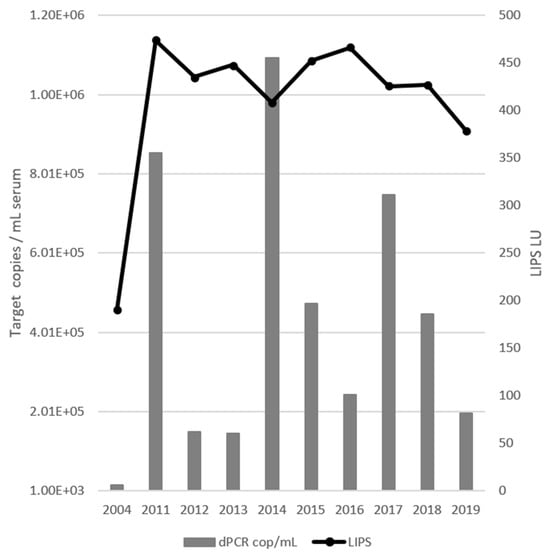
Figure 1
Open AccessArticle
Respiratory Syncytial Virus Induces B Cell Activating Factor (BAFF) in Airway Epithelium: A Potential Avenue for Mucosal Vaccine Development
by
Wael Alturaiki and Brian Flanagan
Viruses 2025, 17(7), 946; https://doi.org/10.3390/v17070946 - 4 Jul 2025
Abstract
Respiratory syncytial virus (RSV) is a major etiological agent of lower respiratory tract infections, particularly among infants and the elderly. Activation of B cells in the mucosa and the production of specific neutralizing antibodies are essential for protective immunity against pulmonary infection. B-cell
[...] Read more.
Respiratory syncytial virus (RSV) is a major etiological agent of lower respiratory tract infections, particularly among infants and the elderly. Activation of B cells in the mucosa and the production of specific neutralizing antibodies are essential for protective immunity against pulmonary infection. B-cell activating factor (BAFF) is a critical survival factor for B cells and has been associated with antiviral responses; however, its regulation during RSV infection remains poorly understood. This study examined BAFF regulation in BEAS-2B cells exposed to RSV or IFN-β. The treatments resulted in a progressive increase in gene expression over time, accompanied by higher protein levels. BAFF mRNA peaked at 12 h post-infection and declined by 48 h, coinciding with the release of soluble BAFF protein into the culture supernatant. Pre-treatment with anti-IFN-β antibodies prior to RSV infection reduced both BAFF mRNA and protein levels, indicating that IFN-β plays a regulatory role in BAFF production by airway epithelial cells. Western blot analysis revealed membrane-bound BAFF (~31 kDa) in non-infected cells, with elevated expression at 24 h post-infection. By 48 h, this form was cleaved into a soluble ~17 kDa form, which was detected in the supernatant. Immunostaining further demonstrated reduced surface expression of membrane-bound BAFF in RSV-infected cells compared to uninfected controls, suggesting that RSV infection promotes the cleavage and release of BAFF into the extracellular environment. Additionally, the release of BAFF was not affected by furin convertase inhibition or ER–Golgi transport blockade, indicating a potentially novel cleavage mechanism. Co-culturing BAFF produced by BEAS-2B cells with isolated B cells enhanced B cell viability. Overall, these results indicate that RSV infection stimulates BAFF production in airway epithelial cells through a pathway involving IFN-β, potentially contributing to B cell activation and promoting local antibody-mediated immunity. Understanding this mechanism may offer valuable insights for improving mucosal vaccine strategies and enhancing immunity against respiratory pathogens.
Full article
(This article belongs to the Section Viral Immunology, Vaccines, and Antivirals)
►▼
Show Figures
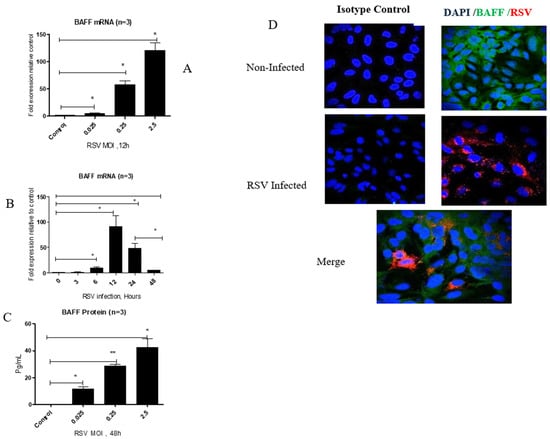
Figure 1
Open AccessArticle
Homoharringtonine Inhibits CVS-11 and Clinical Isolates of Rabies Virus In Vitro: Identified via High-Throughput Screening of an FDA-Approved Drug Library
by
Kalenahalli Rajappa Harisha, Varun Kailaje, Ravinder Reddy Kondreddi, Chandra Sekhar Gudla, Shraddha Singh, Sharada Ramakrishnaiah, Shrikrishna Isloor, Shridhar Narayanan, Radha Krishan Shandil and Gudepalya Renukaiah Rudramurthy
Viruses 2025, 17(7), 945; https://doi.org/10.3390/v17070945 - 4 Jul 2025
Abstract
Rabies, a viral encephalitis caused by rabies virus (RABV), is 100% fatal upon the onset of symptoms. Effective post-exposure prophylaxis (PEP) measures are available, but they are often difficult to access in low-income countries. WHO estimates about 59,000 deaths due to rabies globally,
[...] Read more.
Rabies, a viral encephalitis caused by rabies virus (RABV), is 100% fatal upon the onset of symptoms. Effective post-exposure prophylaxis (PEP) measures are available, but they are often difficult to access in low-income countries. WHO estimates about 59,000 deaths due to rabies globally, and the majority are contributed by developing countries. Hence, developing drugs for the treatment of post-symptomatic rabies is an urgent and unmet demand. It is worth noting that previous efforts regarding antiviral strategies, such as small-interfering RNA, antibodies and small-molecule inhibitors, against the rabies virus have failed to show efficacy in pre-clinical studies, especially when the virus has reached the central nervous system (CNS). Therefore, drug repurposing seems to be an alternative tool for the development of new anti-rabies drugs. We validated and used a high-throughput, FITC-conjugated antibody-based flow cytometry assay to expedite the identification of repurposable new drug candidates against the RABV. The assay was validated using ribavirin and salinomycin as reference compounds, which showed EC50 values of 10.08 µM and 0.07 µM, respectively. We screened a SelleckChem library comprising 3035 FDA-approved compounds against RABV (CVS-11) at 10 µM concentration. Five compounds (clofazimine, tiamulin, difloxacin, harringtonine and homoharringtonine) were active against RABV, with greater than 90% inhibition. Homoharringtonine (HHT) identified in the present study is active against laboratory-adapted RABV (CVS-11) and clinical isolates of RABV, with an average EC50 of 0.3 µM in both BHK-21 and Neuro-2a cell lines and exhibits post-entry inhibition.
Full article
(This article belongs to the Section Viral Immunology, Vaccines, and Antivirals)
►▼
Show Figures
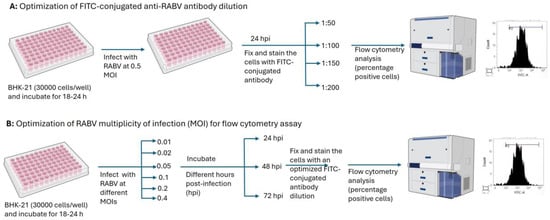
Figure 1
Open AccessArticle
The Gene Expression Profile of Milk Somatic Cells of Small Ruminant Lentivirus-Seropositive and -Seronegative Dairy Goats (Capra hircus) During Their First Lactation
by
Joanna Pławińska-Czarnak, Alicja Majewska, Joanna Magdalena Zarzyńska, Jarosław Kaba and Emilia Bagnicka
Viruses 2025, 17(7), 944; https://doi.org/10.3390/v17070944 - 3 Jul 2025
Abstract
Caprine arthritis and encephalitis (CAE), caused by small ruminant lentivirus (SRLV), is a key disease of goats, with chronic inflammation of joints and brain symptoms leading to losses in milk production and animal trade. In this study, we analyzed gene expressions in the
[...] Read more.
Caprine arthritis and encephalitis (CAE), caused by small ruminant lentivirus (SRLV), is a key disease of goats, with chronic inflammation of joints and brain symptoms leading to losses in milk production and animal trade. In this study, we analyzed gene expressions in the milk somatic cells (MSCs) of seropositive (SRLV-SP) and seronegative (SRLV-SN) goats to identify transcriptomic changes using a non-invasive sampling method. Materials and Methods: This study was conducted on goats of two Polish breeds (Polish Improved White and Polish Improved Fawn), which were kept at the Institute of Genetics and Animal Biotechnology, Polish Academy of Sciences, during their first lactation. MSCs were isolated from milk, and gene expression was analyzed using the Goat Gene Expression Microarray. The results were verified by RT-qPCR for five genes (DUSP26, PRLR, SCARA3, APBB2, OR4F4). Statistical analysis was performed in GeneSpring 12 software. Results: Microarrays showed reduced expression of DUSP26, PRLR, SCARA3, APBB2, and OR4F4 genes in SRLV-SP goats. RT-qPCR confirmed changes for DUSP26, SCARA3, and APBB2. Functional analysis indicated associations with immune processes and HIV-like pathways. Discussion: The results suggest that SRLV induces transcriptomic perturbations, especially in immunity-related genes. MSCs are an effective model for non-invasive studies, and further studies may support strategies for combating CAE.
Full article
(This article belongs to the Special Issue Viral Diseases of Sheep and Goats)
►▼
Show Figures
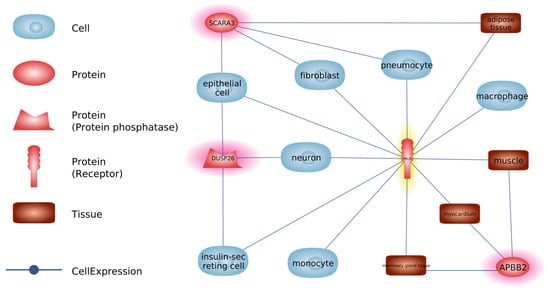
Figure 1
Open AccessArticle
Evidence Generation for a Host-Response Biosignature of Respiratory Disease
by
Kelly E. Dooley, Michael Morimoto, Piotr Kaszuba, Margaret Krasne, Gigi Liu, Edward Fuchs, Peter Rexelius, Jerry Swan, Krzysztof Krawiec, Kevin Hammond, Stuart C. Ray, Ryan Hafen, Andreas Schuh and Nelson L. Shasha Jumbe
Viruses 2025, 17(7), 943; https://doi.org/10.3390/v17070943 - 2 Jul 2025
Abstract
Background: In just twenty years, three dangerous human coronaviruses—SARS-CoV, MERS-CoV, and SARS-CoV-2 have exposed critical gaps in early detection of emerging viral threats. Current diagnostics remain pathogen-focused, often missing the earliest phase of infection. A virus-agnostic, host-based diagnostic capable of detecting responses to
[...] Read more.
Background: In just twenty years, three dangerous human coronaviruses—SARS-CoV, MERS-CoV, and SARS-CoV-2 have exposed critical gaps in early detection of emerging viral threats. Current diagnostics remain pathogen-focused, often missing the earliest phase of infection. A virus-agnostic, host-based diagnostic capable of detecting responses to viral intrusion is urgently needed. Methods: We hypothesized that the lungs act as biomechanical instruments, with infection altering tissue tension, wave propagation, and flow dynamics in ways detectable through subaudible vibroacoustic signals. In a matched case–control study, we enrolled 19 RT-PCR-confirmed COVID-19 inpatients and 16 matched controls across two Johns Hopkins hospitals. Multimodal data were collected, including passive vibroacoustic auscultation, lung ultrasound, peak expiratory flow, and laboratory markers. Machine learning models were trained to identify host-response biosignatures from anterior chest recordings. Results: 19 COVID-19 inpatients and 16 matched controls (mean BMI 32.4 kg/m2, mean age 48.6 years) were successfully enrolled to the study. The top-performing, unoptimized, vibroacoustic-only model achieved an AUC of 0.84 (95% CI: 0.67–0.92). The host-covariate optimized model achieved an AUC of 1.0 (95% CI: 0.94–1.0), with 100% sensitivity (95% CI: 82–100%) and 99.6% specificity (95% CI: 85–100%). Vibroacoustic data from the anterior chest alone reliably distinguished COVID-19 cases from controls. Conclusions: This proof-of-concept study demonstrates that passive, noninvasive vibroacoustic biosignatures can detect host response to viral infection in a hospitalized population and supports further testing of this modality in broader populations. These findings support the development of scalable, host-based diagnostics to enable early, agnostic detection of future pandemic threats (ClinicalTrials.gov number: NCT04556149).
Full article
(This article belongs to the Section Viral Immunology, Vaccines, and Antivirals)
►▼
Show Figures

Figure 1
Open AccessReview
Medicinal Mushrooms, Probiotics and Combination of Natural Compounds in the Management of HPV: A Comparative Look at Viral Clearance and Lesion Resolution
by
Giuseppina Porcaro, Marco Calcagno and Andrea Tinelli
Viruses 2025, 17(7), 942; https://doi.org/10.3390/v17070942 - 2 Jul 2025
Abstract
Despite the fact that human papillomavirus (HPV) infections are common, there are currently no proven treatment approaches for persistent infections. A promising strategy to promote HPV clearance and the regression of caused lesions is dietary supplementation with natural compounds. This review evaluates available
[...] Read more.
Despite the fact that human papillomavirus (HPV) infections are common, there are currently no proven treatment approaches for persistent infections. A promising strategy to promote HPV clearance and the regression of caused lesions is dietary supplementation with natural compounds. This review evaluates available supplement formulations proposed in HPV care, focusing on combinations of epigallocatechin gallate (EGCG), folic acid (FA), vitamin B12 (B12), and hyaluronic acid (HA), as well as medicinal mushrooms and probiotics. The combination of EGCG, FA, B12, and HA is supported by the most consistent evidence, which shows a high rate of HPV clearance and lesion resolution across several clinical investigations. Medicinal mushrooms and probiotics have also shown some evidence of beneficial effects, although the diverse designs of the reported clinical studies may limit the observed findings. Overall, natural molecule-based supplements showed promising safety and efficacy profiles in the management of HPV persistent infection, supporting their clinical use. Of course, further investigations through well-designed, large-scale, randomized controlled trials will be necessary to provide strong support.
Full article
(This article belongs to the Section Human Virology and Viral Diseases)
►▼
Show Figures
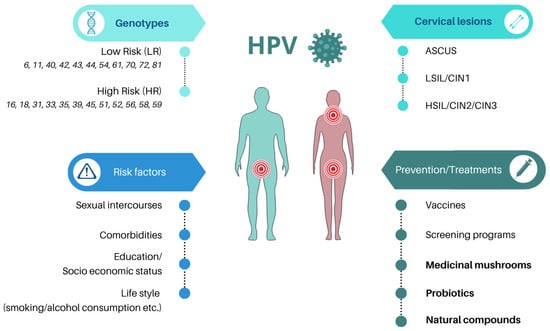
Figure 1
Open AccessArticle
In Silico Analysis of Mechanisms of Maribavir-Induced Inhibition and Drug Resistance Mutations in pUL97 Kinase Structural Prediction with AlphaFold2
by
Jocelyne Piret and Guy Boivin
Viruses 2025, 17(7), 941; https://doi.org/10.3390/v17070941 - 2 Jul 2025
Abstract
Infections with cytomegalovirus (CMV) can result in increased morbidity and mortality in immunocompromised patients. The pUL97 kinase is a critical enzyme in the regulation of CMV replication. Although it does not phosphorylate deoxynucleosides, this enzyme is involved in the first phosphorylation step of
[...] Read more.
Infections with cytomegalovirus (CMV) can result in increased morbidity and mortality in immunocompromised patients. The pUL97 kinase is a critical enzyme in the regulation of CMV replication. Although it does not phosphorylate deoxynucleosides, this enzyme is involved in the first phosphorylation step of ganciclovir (GCV), a viral DNA polymerase inhibitor. In contrast, maribavir (MBV) is a specific inhibitor of pUL97 kinase activity. In this paper, we analyzed the already-reported amino acid changes, conferring resistance to MBV and cross-resistance to GCV, in the pUL97 protein structure, predicted with AlphaFold2. Docking experiments suggest that MBV is a dual-site inhibitor, targeting ATP binding and substrate phosphorylation. Substitutions that confer resistance to MBV only may directly or indirectly alter the shape of the cavity in the vicinity of the invariant K355 in the putative ATP binding site, without affecting the viral growth. The most frequently encountered T409M substitution may correspond to a gatekeeper mutation. Substitutions that induce cross-resistance to MBV and GCV may directly or indirectly affect the environment of D456 and N461 residues in the catalytic loop, with reduced viral replicative capacity. These results have implications for the clinical use of MBV as well as for the design of novel pUL97 kinase inhibitors.
Full article
(This article belongs to the Special Issue Mechanisms of Herpesvirus Resistance)
►▼
Show Figures

Figure 1

Journal Menu
► ▼ Journal Menu-
- Viruses Home
- Aims & Scope
- Editorial Board
- Reviewer Board
- Topical Advisory Panel
- Instructions for Authors
- Special Issues
- Topics
- Sections & Collections
- Article Processing Charge
- Indexing & Archiving
- Editor’s Choice Articles
- Most Cited & Viewed
- Journal Statistics
- Journal History
- Journal Awards
- Society Collaborations
- Conferences
- Editorial Office
Journal Browser
► ▼ Journal BrowserHighly Accessed Articles
Latest Books
E-Mail Alert
News
Topics

Conferences
30 October–2 November 2025
The 11th Wuhan International Symposium on Modern Virology & Viruses 2025 Conference

Special Issues
Special Issue in
Viruses
Advances in Small-Molecule Viral Inhibitors
Guest Editor: Chiara BertagninDeadline: 15 July 2025
Special Issue in
Viruses
Arboviral Diseases in Livestock
Guest Editors: Estelle Venter, Antoinette Van SchalkwykDeadline: 15 July 2025
Special Issue in
Viruses
Unraveling the Pathogenesis of Persistent Virus Infection
Guest Editors: Yasuko Tsunetsugu-Yokota, Mie Kobayashi-IshiharaDeadline: 15 July 2025
Special Issue in
Viruses
Glycans in Virus-Host Interactions
Guest Editor: Rahul RamanDeadline: 15 July 2025
Topical Collections
Topical Collection in
Viruses
Mathematical Modeling of Viral Infection
Collection Editors: Amber M. Smith, Ruian Ke








